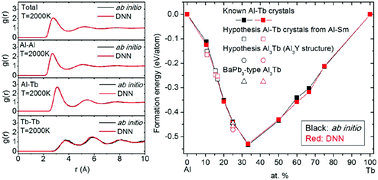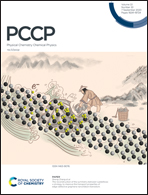Development of interatomic potential for Al–Tb alloys using a deep neural network learning method†
Abstract
An interatomic potential for the Al–Tb alloy around the composition of Al90Tb10 is developed using the deep neural network (DNN) learning method. The atomic configurations and the corresponding total potential energies and forces on each atom obtained from ab initio molecular dynamics (AIMD) simulations are collected to train a DNN model to construct the interatomic potential for the Al–Tb alloy. We show that the obtained DNN model can well reproduce the energies and forces calculated by AIMD simulations. Molecular dynamics (MD) simulations using the DNN interatomic potential also accurately describe the structural properties of the Al90Tb10 liquid, such as partial pair correlation functions (PPCFs) and bond angle distributions, in comparison with the results from AIMD simulations. Furthermore, the developed DNN interatomic potential predicts the formation energies of the crystalline phases of the Al–Tb system with an accuracy comparable to ab initio calculations. The structure factors of the Al90Tb10 metallic liquid and glass obtained by MD simulations using the developed DNN interatomic potential are also in good agreement with the experimental X-ray diffraction data. The development of short-range order (SRO) in the Al90Tb10 liquid and the undercooled liquid is also analyzed and three dominant SROs, i.e., Al-centered distorted icosahedron (DISICO) and Tb-centered ‘3661’ and ‘15551’ clusters, respectively, are identified.

- This article is part of the themed collection: Emerging AI Approaches in Physical Chemistry


 Please wait while we load your content...
Please wait while we load your content...